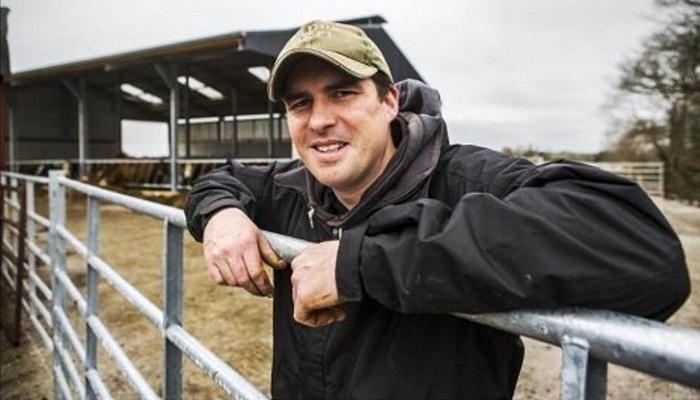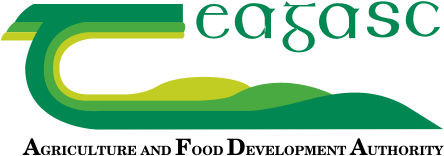12 July 2023
Future Beef Farmer Trevor Boland’s 10 point autumn calving plan

Trevor Boland farms in partnership with his father Joseph in Dromard, Co. Sligo. Along with farming, which centres on a herd of 50 autumn-calving cows, he also works full time as an accountant with IFAC.
The farm size is 48ha, with 23ha owned and 25ha leased. Like most farms in the west of Ireland, it is fragmented into four main blocks.
Trevor’s farm is well stocked at 155kg nitrogen/ha (N/ha). The main enterprise is a 50-cow, autumn-calving suckler herd, from which bull calves are sold at 10-12 months and heifers are sold as either forward stores or finished under 24 months. He also buys in 40 early-maturing heifers in early spring to finish in October/November.
In the below video, Trevor explains why he operates an autumn-calving system:
Focus areas
Compared to spring calving, calving in the autumn can be seen as a higher cost system. To control costs and to eliminate the use of meal, one of Trevor’s key focus areas is to make high-quality silage.
With an aim of calving 100% of cows outdoors, calving commences on August 1st and runs through to the end of October. During the lead up to calving, Trevor focuses on a number of key areas to ensure a stress-free calving period. These are detailed below:
1) Maintaining the correct body condition
Having cows at the correct body condition score leading up to calving is critical. Cows that are over-fat have an increased risk of difficult calvings, due to fat deposits in the birth canal – thus reducing the available area in the pelvis.
As the dry cows are on grass for the summer, they can easily become too fat. To prevent this, Trevor manages grazing carefully; cows are grazed very tightly on low grass covers (600-700kg DM/ha) on a rotational basis. The group will spend two days in each of the 14 paddocks allocated, with the aim of maintaining a body condition score of 3 – a ‘fit’ condition.
2) Mastitis
Keeping mastitis at bay is a challenge. There is no one solution that gives the best results and Trevor uses a combination of products. A pour-on, like Spot On, is used on a regular basis and garlic licks are put out with the cows from early June onwards. In addition, Trevor uses Stockholm Tar as a deterrent against flies. This creates some extra work, as the tar has to be applied on a weekly basis.
3) Pre-calving mineral
Even though the cows are at grass, Trever administers a bolus in July that contains copper, iodine, selenium and cobalt. This bolus is slow release and will cover the cows for both calving and breeding.
4) Observation
The cows graze a block of land surrounding Trevor’s house. Near the point of calving, the cow is moved to the paddocks adjacent to the house and yard. As the day is long, Trevor can easily check early in the morning, evening and late at night
5) Managing heifers
With seven heifers due to calve – a group that potentially will need some assistance – Trevor houses this group a couple of weeks before calving in August. As well as having excellent calving facilities on hand, he can also observe them using a camera. Once calved successfully, the young mother and calf can bond in a pen and are let out as soon as possible post calving.
6) Calving outside – safety first
Cows calving outside can have more protective instincts and care is taken when attending to the new born calf. No strangers, children, or people with reduced mobility are allowed near cows with new born calves. The behaviour of the cows is monitored and recorded every year and, if safe to do so, the calf is tagged in the field, keeping the calf between the cow and Trevor.
An escape route is always close by due to the small size of the paddocks. If a cow is showing protective instincts, the cow and calf are brought to the yard to tag. Yearly records can help identify difficult cows, but overall safety is always borne in mind.
7) Post-calving management
The cow and calf are allowed to bond and Trevor ensures that the calf is sucking. The cow is kept on the low covers for another week, as she will have plenty of milk for a week old calf. The land around the yard will have a bank of good quality grass for the cows and calves. The land used for second-cut silage will have been fertilised and closed until grazing in August. After a week post calving, the cow and calf are moved to that block.
8) Tetany risk
The downside of grazing lush grass is that tetany becomes a bigger risk, especially in late September and early October when the weather becomes variable. Cows are supplemented with magnesium lick buckets and are watched carefully during this time.
9) Calf vaccination
In recent years, Trevor has been vaccinating the calves at seven days with Bovilis Bovipast RSP. This helps to protect the calf against bovine respiratory diseases caused by Paraininfluenza – 3 virus, bovine respiratory syncytical virus and mannheimia.
10) Calving aids
Trevor will ensure that he has all the calving aids stocked up in July in case any cows calve earlier than expected. Essentials like gloves, lubricant, naval dips and ropes will be checked and purchased where necessary. Last year, only two cows needed assistance, but proper preparation is key to a stress-free calving period for both animal and farmer.
For more information on Trevor Boland’s farm, click here. This article first appear in the Future Beef newsletter. To sign up to future newsletters, which offer timely advice and regular updates from farmers enrolled in the programme, visit the Future Beef webpage.
